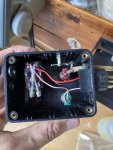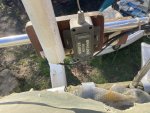tymonk
Active Member
Hi. There is a Navtex in a second hand boat I purchased. The former owner (unfortunately deceased) has wired his Navtex up to a little switch box. 3 cables come out of the Navtex (red/black/orange, which I assume is +/-/ground) + the antenna cable. These wires go to their respective colour, and the orange one to the pink cable in the pictures. Next to the switch box are 4 wires: a positive and a negative, and 2 antenna cables. There are 2 Navtex antennas as the back. My assumption has been that the former owner wanted a way to both turn the Navtex on and off, and a way to switch between both antennas. However, it really confuses me that what I assume is the ground cable (pink wire in the picture) is linked to one of the switches, and why this connects to the red wire. I assume each antenna cable can be connected to the top/bottom of the of the antenna switch, and that the wire connecting it to the housing is the antenna ground? Apparently he was an electrical engineer and knew what he was doing.
If anybody can help decipher this and recommend on a way forward (potentially finishing this wiring project he started!) it would be much appreciated.


If anybody can help decipher this and recommend on a way forward (potentially finishing this wiring project he started!) it would be much appreciated.


